Sending Faxes after Previewing in the Desktop Editor Screen
By using a print settings button or fax output button on the Desktop Browser screen, you can specify the pages to send via fax while checking a preview of the send image in Desktop Editor screen.
|
NOTE
|
|
To send a document by fax from the output bar on the Desktop Browser screen, it is necessary to register a fax output button in the output bar. Also, to check previews on the Desktop Editor screen using a fax output button, [Check preview with Editor when sending fax] must be selected in the fax output button settings. For information on registering and setting buttons, see the following.
You can retrieve the fax number from the document properties. For more information, see the following.
If you use the Windows fax properties dialog box to change the name of a fax when that fax has already been registered to a fax output button, you will not be able to fax that document using the fax output button.
If you send an image whose width or height exceeds 482.6 mm (19 inches) via fax, it is reduced to fit inside 482.6 mm (19 inches), with the aspect ratio retained.
If a paper size is specified in the output size settings, the image is reduced to fit the specified paper size.
If [Auto (Size)] is selected in the output size settings, the image is reduced to fit the paper size specified in [Reduced Image Paper Size]. However, the paper size selected when printing may differ from the specified paper size, depending on the shape of the image.
[File] menu > [Option] > [System Settings] > [Common Settings] > [Import] > [Reduced Image Paper Size]
When multiple output paper sizes are selected (for example, A4 and A3), the image is reduced to fit the larger paper size.
If information for the resolution is not included in the image, the image is converted to 96 dpi when reduced.
To send faxes with the IP fax function, your device must support the IP fax function.
|
Sending Faxes with Desktop Editor
You can use the [Send Fax] dialog box to specify settings such as the range of pages to send, and send a document by fax.
1.
Select a document/folder to fax in the File List View Window, and click  (print settings button).
(print settings button).
Or, follow one of the steps described below.
Drag and drop the document/folder to  (print settings button)
(print settings button)
Click  (fax output button)
(fax output button)
Drag and drop the document/folder to  (fax output button)
(fax output button)
Right-click to select the document or folder, drag and drop it to  (print settings button) or
(print settings button) or  (fax output button), and select [Multiple Document Order Settings] from the displayed menu
(fax output button), and select [Multiple Document Order Settings] from the displayed menu
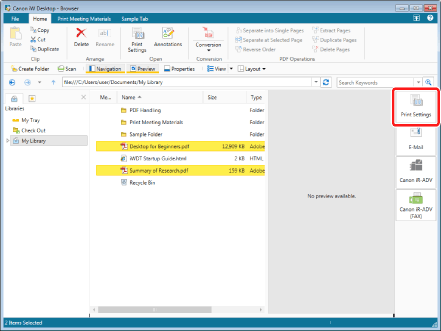
When you select a single document, Desktop Editor starts and a preview of the document to fax is displayed. Proceed to step 4.
When you select multiple documents or folders, the [Multiple Document Order Settings] dialog box is displayed. In this case, proceed to step 2.
If you selected [Multiple Document Order Settings] in step 1, proceed to step 2.
|
NOTE
|
|
When the selected documents contain an IWB document, a confirmation message appears to inform you that any existing print settings for that IWB document will not be reflected. In this case, click [OK]. When you select the [Do not show this message again] check box, this message will not appear the next time.
You can also use one of the following methods to perform the same operation.
Click
Click
 (Print Settings) displayed on the toolbar (Print Settings) displayed on the toolbarClick
 for a fax output button displayed on the ribbon or toolbar for a fax output button displayed on the ribbon or toolbarClick
 for a fax output button displayed on the ribbon or toolbar, and select [Execution] for a fax output button displayed on the ribbon or toolbar, and select [Execution]If buttons are not displayed on the ribbon or toolbar, see the following to display them.
|
2.
Select a document in [Document Processing Order] and click [Up] or [Down] to specify the order in which to fax the documents.
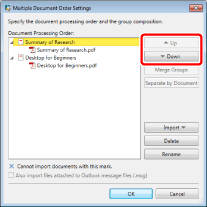
|
NOTE
|
|
For more information on the [Multiple Document Order Settings] dialog box, see the following.
|
3.
Click [OK].
Desktop Editor starts and the document preview is displayed.
4.
Check the preview displayed on the Desktop Editor screen, click  (Printer) on the ribbon, and select the fax driver to use from the pull-down list.
(Printer) on the ribbon, and select the fax driver to use from the pull-down list.
 (Printer) on the ribbon, and select the fax driver to use from the pull-down list.
(Printer) on the ribbon, and select the fax driver to use from the pull-down list.Or, select the fax driver to use in  (Printer Name) on the Details Window.
(Printer Name) on the Details Window.
 (Printer Name) on the Details Window.
(Printer Name) on the Details Window.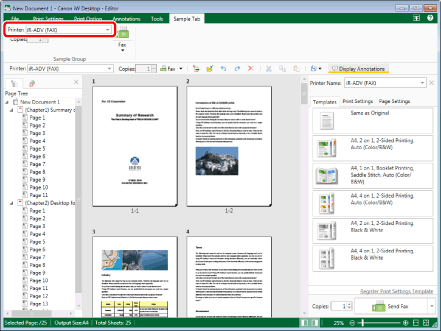
If a confirmation message is displayed, proceed to step 5.
If a confirmation message is not displayed, proceed to step 6.
|
NOTE
|
|
If you change the driver to use from a printer driver to a fax driver, [Print] automatically changes to [Fax].
If the Details Window is not displayed, see the following.
If the Desktop Editor preview quality is not good, selecting [High quality] in [System Settings] may resolve this.
[File] menu > [Option] > [System Settings] > [Common Settings] > [Display Settings] > [Select The Image Quality To Be Displayed In The Preview]
If commands are not displayed on the ribbon of Desktop Editor, see the following to display them.
This operation can also be performed with the tool buttons on the toolbar. If tool buttons are not displayed on the toolbar of Desktop Editor, see the following to display them.
|
5.
Click [Yes].

6.
Click  for
for  (Fax) on the ribbon, and select [Display Send Fax Dialog].
(Fax) on the ribbon, and select [Display Send Fax Dialog].
 for
for  (Fax) on the ribbon, and select [Display Send Fax Dialog].
(Fax) on the ribbon, and select [Display Send Fax Dialog].Or, follow one of the steps described below.
Click  (Send Fax Dialog) on the ribbon
(Send Fax Dialog) on the ribbon
 (Send Fax Dialog) on the ribbon
(Send Fax Dialog) on the ribbonClick  (Print) on the ribbon
(Print) on the ribbon
 (Print) on the ribbon
(Print) on the ribbonClick  for
for  on the Details Window, and select [Display Send Fax Dialog]
on the Details Window, and select [Display Send Fax Dialog]
Select the [File] menu > [Print]
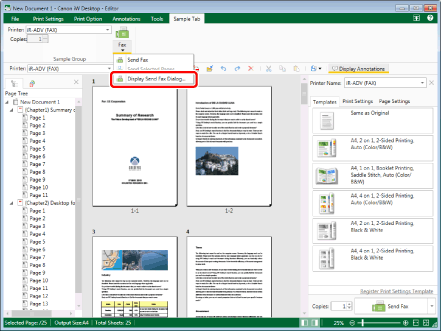
The [Send Fax] dialog box is displayed.
|
NOTE
|
|
If one of the following operations is performed, the [Fax Sending Settings] dialog box is displayed. In this case, proceed to step 11.
Click
 for for  (Fax) on the ribbon or (Fax) on the ribbon or Click
 for for  (Fax) on the ribbon or (Fax) on the ribbon or However, if the [Display print/send fax dialog] check box is deselected, a confirmation message is displayed if you perform an operation when annotations are hidden. To print the annotations, click [Print with annotations].
The [Send Fax] dialog box is displayed if the [Display print/send fax dialog] check box is selected. In this case, proceed to step 7.
[File] menu > [Option] > [System Settings] > [Common Settings] > [Print/Fax] > [Processing when printing/sending fax] > [Display print/send fax dialog]
If commands are not displayed on the ribbon of Desktop Editor, see the following to display them.
This operation can also be performed with the tool buttons on the toolbar. If tool buttons are not displayed on the toolbar of Desktop Editor, see the following to display them.
|
7.
To specify the pages to fax, select [Print Pages] in [Target] and specify the page number in the displayed [Range].
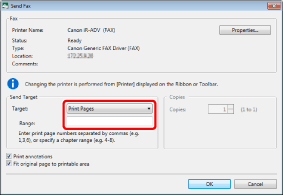
You can use the following formats to specify a range of page numbers.
When sending from page "a" to the last page: a-
("a" indicates the page number to start sending)
When sending from the first page to page "b": -b
("b" indicates the page number to end sending)
When printing continuous pages: a-b
("a" and "b" indicate the page numbers to start and end sending respectively)
When printing discontinuous pages: c,d
("c" and "d" indicate the individual page numbers to send, separated by commas)
|
NOTE
|
|
The entry order of [Range] is not the order of sending. Regardless of whether you enter "1,2" or "2,1", pages are sent in the order "1,2."
|
8.
Select the [Print annotations] check box to include annotations when sending the fax.
|
NOTE
|
|
Annotations added with something other than Desktop Editor may be printed regardless of whether you select the [Print annotations] check box, depending on the type of annotation.
|
9.
Select the [Fit original page to printable area] check box to send the fax according to the valid print area.
10.
Click [OK].
The [Fax Sending Settings] dialog box is displayed.
|
NOTE
|
|
If the header/footer of a page to send overlaps with the margin of the paper, a confirmation message is displayed. Adjust the position of the header/footer based on the paper margins displayed in the message.
|
11.
Configure the fax destination.
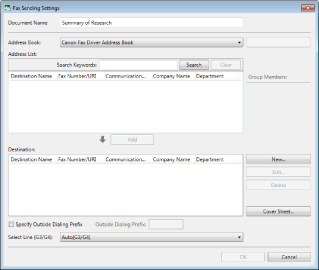
|
NOTE
|
|
For details on how to set the destination address, see the following.
|
12.
Configure the cover sheet settings if necessary.
|
NOTE
|
|
For more information on how to configure cover sheet settings, see the following.
|
13.
To specify a job name for the fax document to be sent, enter the name in [Document Name].
14.
To send a document using an external number, select the [Specify Outside Dialing Prefix] check box and enter the fax number in [Outside Dialing Prefix].
15.
When specifying the line to be used, select it from the [Select Line (G3/G4)] pull-down list.
Select [Auto (G3/G4)] when specifying line is not required. Send faxes using the prior sending line specified by the device.
|
NOTE
|
|
If you send a fax with the IP fax function, this setting will be disabled.
|
16.
Click [OK].
The faxing starts.
|
NOTE
|
|
For more information on the status of fax jobs, see the following.
|
17.
When the fax transmission is completed, close the Desktop Editor screen.
Save the document shown in the screen if necessary.
Faxing Selected Pages with Desktop Editor
You can send the pages selected in the Navigation Window or Work Window of Desktop Editor via fax.
1.
Select a document/folder to fax in the File List View Window, and click  (print settings button).
(print settings button).
Or, follow one of the steps described below.
Drag and drop the document/folder to  (print settings button)
(print settings button)
Click  (fax output button)
(fax output button)
Drag and drop the document/folder to  (fax output button)
(fax output button)
Right-click to select the document or folder, drag and drop it to  (print settings button) or
(print settings button) or  (fax output button), and select [Multiple Document Order Settings] from the displayed menu
(fax output button), and select [Multiple Document Order Settings] from the displayed menu

When you select a single document, Desktop Editor starts and a preview of the document to fax is displayed. Proceed to step 4.
When you select multiple documents or folders, the [Multiple Document Order Settings] dialog box is displayed. In this case, proceed to step 2.
If you selected [Multiple Document Order Settings] in step 1, proceed to step 2.
|
NOTE
|
|
When the selected documents contain an IWB document, a confirmation message appears to inform you that any existing print settings for that IWB document will not be reflected. In this case, click [OK]. When you select the [Do not show this message again] check box, this message will not appear the next time.
You can also use one of the following methods to perform the same operation.
Click
 (Print Settings) on the ribbon (Print Settings) on the ribbonClick
 (Print Settings) displayed on the toolbar (Print Settings) displayed on the toolbarClick
 for a fax output button displayed on the ribbon or toolbar for a fax output button displayed on the ribbon or toolbarClick
 for a fax output button displayed on the ribbon or toolbar, and select [Execution] for a fax output button displayed on the ribbon or toolbar, and select [Execution] If buttons are not displayed on the ribbon or toolbar, see the following to display them.
|
2.
Select a document in [Document Processing Order] and click [Up] or [Down] to specify the order in which to fax the documents.

|
NOTE
|
|
For more information on the [Multiple Document Order Settings] dialog box, see the following.
|
3.
Click [OK].
Desktop Editor starts and the document preview is displayed.
4.
Check the preview displayed on the Desktop Editor screen, click  (Printer) on the ribbon, and select the fax driver to use from the pull-down list.
(Printer) on the ribbon, and select the fax driver to use from the pull-down list.
 (Printer) on the ribbon, and select the fax driver to use from the pull-down list.
(Printer) on the ribbon, and select the fax driver to use from the pull-down list.Or, select the fax driver to use in  (Printer Name) on the Details Window.
(Printer Name) on the Details Window.
 (Printer Name) on the Details Window.
(Printer Name) on the Details Window.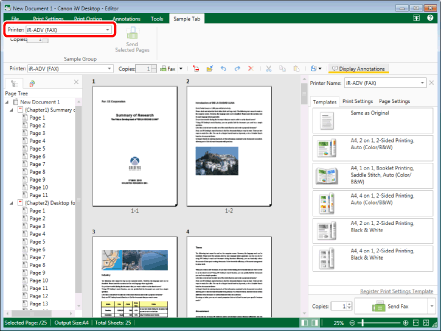
If a confirmation message is displayed, proceed to step 5.
If a confirmation message is not displayed, proceed to step 6.
|
NOTE
|
|
If you change the driver to use from a printer driver to a fax driver, [Print] automatically changes to [Fax].
If the Details Window is not displayed, see the following.
If the Desktop Editor preview quality is not good, selecting [High quality] in [System Settings] may resolve this.
[File] menu > [Option] > [System Settings] > [Common Settings] > [Display Settings] > [Select The Image Quality To Be Displayed In The Preview]
If commands are not displayed on the ribbon of Desktop Editor, see the following to display them.
This operation can also be performed with the tool buttons on the toolbar. If tool buttons are not displayed on the toolbar of Desktop Editor, see the following to display them.
|
5.
Click [Yes].

6.
Select the pages to fax in the Navigation Window or Work Window.
|
NOTE
|
|
For information on how to select a page, see the following.
|
7.
Click  (Send Selected Pages) on the ribbon.
(Send Selected Pages) on the ribbon.
 (Send Selected Pages) on the ribbon.
(Send Selected Pages) on the ribbon.Or, follow one of the steps described below.
Click  for
for  (Fax) on the ribbon, and select [Send Selected Pages]
(Fax) on the ribbon, and select [Send Selected Pages]
 for
for  (Fax) on the ribbon, and select [Send Selected Pages]
(Fax) on the ribbon, and select [Send Selected Pages]Click  for
for  on the Details Window, and select [Send Selected Pages]
on the Details Window, and select [Send Selected Pages]
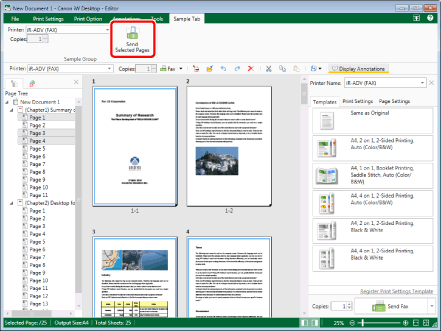
The [Fax Sending Settings] dialog box is displayed.
|
NOTE
|
|
If the [Display print/send fax dialog] check box is deselected, a confirmation message is displayed if you perform an operation when annotations are hidden. To fax the annotations, click [Print with annotations].
If the [Display print/send fax dialog] check box is selected, the [Send Fax] dialog box is displayed. For more information on using the [Send Fax] dialog box to send documents via fax, see the following.
[File] menu > [Option] > [System Settings] > [Common Settings] > [Print/Fax] > [Display print/send fax dialog]
If the header/footer of a page to send overlaps with the margin of the paper, a confirmation message is displayed. Adjust the position of the header/footer based on the paper margins displayed in the message.
If commands are not displayed on the ribbon of Desktop Editor, see the following to display them.
This operation can also be performed with the tool buttons on the toolbar. If tool buttons are not displayed on the toolbar of Desktop Editor, see the following to display them.
|
8.
Configure the fax destination.

|
NOTE
|
|
For details on how to set the destination address, see the following.
|
9.
Configure the cover sheet settings if necessary.
|
NOTE
|
|
For more information on how to configure cover sheet settings, see the following.
|
10.
To specify a job name for the fax document to be sent, enter the name in [Document Name].
11.
To send a document using an external number, select the [Specify Outside Dialing Prefix] check box and enter the fax number in [Outside Dialing Prefix].
12.
When specifying the line to be used, select it from the [Select Line (G3/G4)] pull-down list.
Select [Auto (G3/G4)] when specifying line is not required. Send faxes using the prior sending line specified by the device.
|
NOTE
|
|
If you send a fax with the IP fax function, this setting will be disabled.
|
13.
Click [OK].
The faxing starts.
|
NOTE
|
|
For more information on the status of fax jobs, see the following.
|
14.
When the fax transmission is completed, close the Desktop Editor screen.
Save the document shown in the screen if necessary.